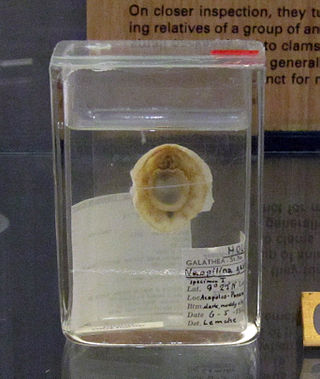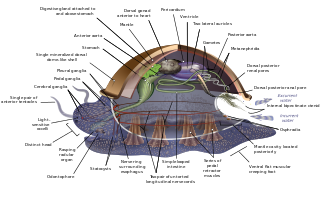
A cephalopod is any member of the molluscan class Cephalopoda such as a squid, octopus, cuttlefish, or nautilus. These exclusively marine animals are characterized by bilateral body symmetry, a prominent head, and a set of arms or tentacles modified from the primitive molluscan foot. Fishers sometimes call cephalopods "inkfish", referring to their common ability to squirt ink. The study of cephalopods is a branch of malacology known as teuthology.

The nautilus is an ancient pelagic marine mollusc of the cephalopod family Nautilidae. The nautilus is the sole extant family of the superfamily Nautilaceae and of its smaller but near equal suborder, Nautilina.

Chitons are marine molluscs of varying size in the class Polyplacophora, formerly known as Amphineura. About 940 extant and 430 fossil species are recognized.

Monoplacophora, meaning "bearing one plate", is a polyphyletic superclass of molluscs with a cap-like shell inhabiting deep sea environments. Extant representatives were not recognized as such until 1952; previously they were known only from the fossil record, and were thought to have become extinct 375 million years ago.

The tusk shells or tooth shells, technically the Scaphopoda, are members of a class of shelled marine mollusc with worldwide distribution, and are the only class of exclusively infaunal marine molluscs. Shells of species within this class range from about 0.5 to 18 cm in length. Members of the order Dentaliida tend to be larger than those of the order Gadilida.

The osphradium is a pigmented chemosensory epithelium patch in the mantle cavity present in six of the eight extant classes of molluscs, on or adjacent to the ctenidia (gills). The main function of this organ is disputed but it is believed to be used to test incoming water for silt and possible food particles or, in some species, for sensing the presence of light.

The evolution of the molluscs is the way in which the Mollusca, one of the largest groups of invertebrate animals, evolved. This phylum includes gastropods, bivalves, scaphopods, cephalopods, and several other groups. The fossil record of mollusks is relatively complete, and they are well represented in most fossil-bearing marine strata. Very early organisms which have dubiously been compared to molluscs include Kimberella and Odontogriphus.

The molluscshell is typically a calcareous exoskeleton which encloses, supports and protects the soft parts of an animal in the phylum Mollusca, which includes snails, clams, tusk shells, and several other classes. Not all shelled molluscs live in the sea; many live on the land and in freshwater.

Mollusca is the second-largest phylum of invertebrate animals, after Arthropoda; members are known as molluscs or mollusks. Around 76,000 extant species of molluscs are recognized. The number of fossil species is estimated between 60,000 and 100,000 additional species. The proportion of undescribed species is very high. Many taxa remain poorly studied.

The molluscs have the widest variety of eye morphologies of any phylum, and a large degree of variation in their function. Cephalopods such as octopus, squid, and cuttlefish have eyes as complex as those of vertebrates, while scallops have up to 100 simple eyes.
The Kirengellids are a group of problematic Cambrian fossil shells of marine organisms. The shells bear a number of paired muscle scars on the inner surface of the valve.
The cephalopods have a long geological history, with the first nautiloids found in late Cambrian strata, and purported stem-group representatives present in the earliest Cambrian lagerstätten.

Yaroslav Igorevich Starobogatov was a Russian zoologist, professor and chief scientist at the Zoological Institute of the Russian Academy of Sciences. His research was on invertebrate zoology, particularly on molluscs (malacology) and crustaceans (carcinology). He also was a major contributor to the higher systematics of living organisms, to micro- and macroevolution and to Soviet and world-wide biogeography.

Tryblidiida is a taxon of monoplacophoran molluscans containing the only extant representatives: 37 species are still alive today, inhabiting the ocean at depths of between 175 and 6,400 metres.
The oesophageal pouches are a pair of pouches connected to the oesophagus of all molluscs, and represent a synapomorphy of the phylum.
Henning Mourier Lemche was a Danish zoologist.
Laevipilina antarctica is a species of monoplacophoran, a superficially limpet-like marine mollusk. It is found in the Weddell Sea and the Lazarev Sea of Antarctica.
Neopilina bruuni is a species of monoplacophoran, a superficially limpet-like marine mollusc. It is found in the southeastern Pacific Ocean, off the coast of South America.

Neopilina galatheae is a species of monoplacophoran, a superficially limpet-like marine mollusc. Its name means new Pilina. It lives in depths of 5000 meters and the shell is 3 centimeters in length in adults.
Neopilina rebainsi is a species of monoplacophoran, a superficially limpet-like marine mollusc. The holotype was collected southeast of the Falkland Islands in the Southern Atlantic Ocean. They are dioecious organisms.











